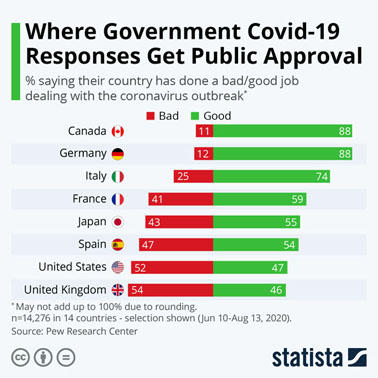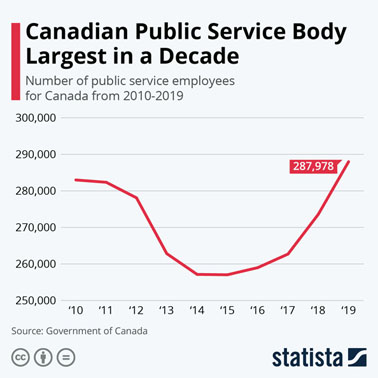Waiting for the Canadian federal Throne Speech on September 23 (which may or may not lead to an election this fall??)
Sep 7th, 2020 | By Counterweights Editors | Category: In Brief
QUIKNOTES FROM THE DESKTOP(S) OF THE COUNTERWEIGHTS EDITORS. SAT/SUN/MON, SEP 5/6/7, 2020. Canadian federal politics – at least trying to compete for attention with the serious world-historical circus next door – is now tilted toward the Trudeau Liberals’ “better-life-in-the-new-future” Throne Speech on September 23, 2020.
Meanwhile there is a new Conservative leader, who is at least not as unpopular as the old leader. And the NDP leader has had (in the words of one pollster) “positives edging upward over the summer to 37%, the highest positive number we have ever registered for Mr. Singh.”
Tale of two polls
The immediate result seems to peer out from the latest two polls – by Angus Reid in Vancouver and Abacus in Ottawa. Both show a suddenly more competitive race between Liberals and Conservatives (and Liberals and New Democrats!) than (eg) the not-so-long-ago August 12 Mainstreet Research poll with the Liberals at 41%.
Angus Reid has its Canada-wide numbers for August 26—September 1 at Liberals 35% , Conservatives 35%, and New Democrats 17%. (We’ll keep the BQ and Greens out for simplicity for the moment.) Abacus rather similarly has, for August 28—September 3, Liberals 33%, Conservatives 31%, NDP 18%.
There are some intriguing regional differences between the two polls. Angus Reid has the Liberals about tied in BC (33% Lib, 34% Con), and still 7 points ahead of the Conservatives in Ontario. Abacus has Liberals 16 points ahead of the Conservatives in BC, and just 2 points ahead in Ontario. (All of which may just reflect the volatility and uncertainty of the smaller regional numbers in cross-Canada samples.)
Whatever else, it is hard to see how these two latest polls alone can sustain those Liberals who now seem to be arguing that their minority government in Ottawa should just accept a confidence-vote defeat over opposition-party disagreements with the innovative new Throne Speech on September 23, and go to the country in a fresh election.
Fall federal election ??
Future polls may show more promise in this direction. And even CBC poll analyst Éric Grenier, using a broader aggregation of the two latest and other recent polls (as “UPDATED ON SEP 4, 2020 AT 10:22 AM ET”), reports averages of Liberals 36%, Conservatives 31%, NDP 18%.
Grenier also summarizes the current scene with : “The Liberals continue to lead in the polls over the Conservatives and would likely win the most seats if an election were held today. It’s a toss-up whether they could win a majority or not.” Meanwhile both the Conservatives and the New Democrats “have gained over the last month while the Bloc Québécois have held steady.”

If there finally is going to be a fresh Canadian federal election this fall 2020, we will at least have had a first cut at navigating such events in a global pandemic with the New Brunswick provincial election, this coming September 14.
(It falls on a Monday – just a week from Labour Day today. No one seems to be anticipating great problems. Yes “Vote by Mail” is an option for “electors who are not comfortable visiting a voting location.” And Yes there have so far been only two deaths from COVID-19 in New Brunswick. Other parts of the country of course have much worse records.)
Liberal-NDP arrangement ??
If most parties in Ottawa seem determined to avoid a fall election – each for its own good enough reasons – the logical way ahead for a Liberal Throne Speech focussed on boosting the progressive role of government (as rumoured) would be some informal Liberal-NDP alliance.
(In very historical perspective, say, as with Pierre Trudeau’s Liberals and David Lewis’s New Democrats, 1972—1974, or even the written 1985—87 Liberal-NDP Accord in Ontario.)
There are also good reasons for wondering about the practicality of such a thing in the extreme toxic partisan-warfare politics of the early 2020s.
But time will tell – and possibly soon enough.
Strengthening government to strengthen human freedom
Meanwhile again, as a sign of related complexities, one thing about the kind of progressive government Liberals and New Democrats ought to agree on (some would argue) is strengthening the role and size of government to strengthen democracy and human freedom.
Here a recent statista chart – “Canadian Public Service Body Largest in a Decade” – has some particular interest. It shows that the “Number of public service employees for Canada” reached its most recent low at the end of the Harper Conservative regime, and has subsequently been climbing ever since the Justin Trudeau Liberals took office late in 2015.
When this chart was tabled at our latest counterweights editors meeting, a doctor (of philosophy) in our midst noted an intriguing Maclean’s magazine article from 2011 he had recently stumbled across, on other vaguely related historical research.
The article was written by John Geddes, to explain how the notorious 1995 Paul Martin Liberal federal budget cutbacks were less than first met the eye.
Eg : “In 1995, the federal government’s workforce numbered 382,000. That total shrank no smaller than 326,500 in 1999. After touching that low ebb, Ottawa’s hiring picked up again, to the point where 380,700 were working for a federal pay cheque in 2006, the year the Liberals lost power to the Conservatives.”
We haven’t yet been able to check in detail on whether the federal government employment numbers Geddes was using in 2011 are exactly comparable to those statista is using in 2020.
On the face of things, however, comparing the two sources (?just over 380,000 employees in 2006, compared to less than 260,000 in 2014?) does suggest that Conservative governments are much more serious about cutting government employment long term than even Liberal governments who are aggressive about intermittent discipline in public finance.
And this could be something someone might want to consider in evaluating the Trudeau Liberals’ new “better-life-in-the-new-future” Throne Speech on September 23, 2020, especially if it really does focus on boosting the progressive role of government, to help meet the new challenges of post-pandemic economic development. (As some look forward to, and others fear?)


